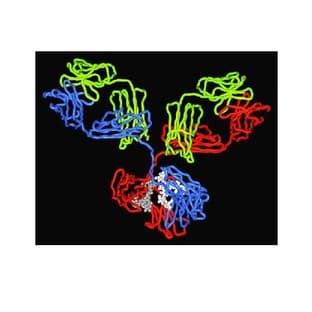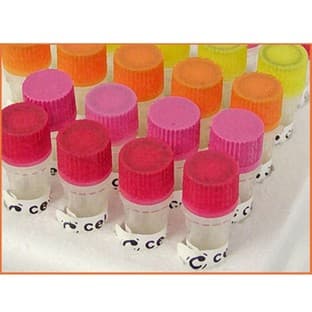
Supplier:
Boster ImmunoleaderCat no: PA1588
Polyclonal Anti-Granzyme A/GZMA
Prices direct from Boster Immunoleader
Quick response times
Exclusive Absave savings/discounts
SPECIFICATIONS
Price
200.00 USD
Catalog Number
PA1588
Size
100ug/vial
Applications
IHC, WB
Reactivities
Hum
Form
Lyophilized
Format
Each vial contains 5mg BSA, 0.9mg NaCl, 0.2mg Na2HPO4, 0.05mg Thimerosal, 0.05mg NaN3.
Gene Id
GZMA
References
1.Fan, Z., Beresford, P. J., Oh, D. Y., Zhang, D., Lieberman, J.Tumor suppressor NM23-H1 is a granzyme A-activated DNase during CTL-mediated apoptosis, and the nucleosome assembly protein SET is its inhibitor.Cell 112: 659-672, 2003. Note: Erratum: Cell 115: 241 only, 2003.\n2. Fink, T. M., Lichter, P., Wekerle, H., Zimmer, M., Jenne, D. E.The human granzyme A (HFSP, CTLA3) gene maps to 5q11-q12 and defines a new locus of the serine protease superfamily.Genomics 18: 401-403, 1993.\n3. Martinvalet, D., Dykxhoorn, D. M., Ferrini, R., Lieberman, J.Granzyme A cleaves a mitochondrial complex I protein to initiate caspase-independent cell death.Cell 133: 681-692, 2008.\n
Swiss Prot
P12544
Storage Temp
At -20 degree C for one year. After reconstitution, at 4 degree C for one month. It can also be aliquotted and stored frozen at -20 degree C for a longer time.Avoid repeated freezing and thawing.
Additional Info
A synthetic peptide corresponding to a sequence in the middle region of human Granzyme A.
Scientific Background
Granzyme A is a protein that in humans is encoded by the GZMA gene. Cytolytic T lymphocytes (CTL) and natural killer (NK) cells share the remarkable ability to recognize, bind, and lyse specific target cells. They are thought to protect their host by lysing cells bearing on their surface 'nonself' antigens, usually peptides or proteins resulting from infection by intracellular pathogens. The protein described here is a T cell- and natural killer cell-specific serine protease that may function as a common component necessary for lysis of target cells by cytotoxic T lymphocytes and natural killer cells. GZMA induces caspase-independent apoptosis in a characteristic manner, except it causes a distinctive form of DNA damage: single-stranded DNA nicking. A target of GZMA is the SET complex, including HMGB2 and ANP32A .
More from Boster Immunoleader
Applications
WB
Reactivities
Hum
Applications
ELISA, WB
Reactivities
Hum
Applications
ELISA, IHC, WB
Reactivities
Hum
Applications
ELISA, WB
Reactivities
Mouse
Applications
ELISA, IHC, WB
Reactivities
Rat
Applications
BNI, ELISA, IHC, IP, WB
Reactivities
Mouse
Conjugates
Unconj, Agarose, AP, Biotin, Gold, HRP, BE, GE, YE, OE, RE, FRE, NIR, ONFC
Applications
BNI, ELISA, IHC, IP, WB
Reactivities
Rat
Latest promotions
Buy any polyclonal or monoclonal antibody from our extensive range of pre-made antibodies and for a limited time only receive a $50 discount!(T&C apply:...
New brilliant antibodies, and new lower prices!For flow cytometry reagents in general, \"bright is better.\" The violet-excitable BD Horizon™ BV421 and...
10% Discount on 2 Rabbit Polyclonal Antibody Service. With over 20 years experience, SDIX has developed into the premier US custom antibody producer,...
For the past decade scientists have extensively used ATS secondary toxin conjugates to make their own targeted toxins for in vitro use.The ability to combine...
We're so sure that you'll prefer Cayman Assay kits over your present brand that we're willing to give you a free assay kit to prove it!
Did your supplier increase the price of Fetal Bovine Serum? Did they substitute the US Origin with USDA? Well say no more! Innovative Research is still...
Bulk Cytokines with Custom Vialing.20 - 50% off cytokines, growth factors, chemokines and more...For a limited time Cell Sciences is offering substantial...
Are you planning to have a customised antibody made for your research?Since 2000, Everest has been producing a catalog containing thousands of affinity...
Top suppliers
Agrisera AB
11 products
Biotrend
Biosensis
969 products
ABBIOTEC
3011 products
SDIX
1 products
Spring Bioscience
2291 products
Cell Signaling Technology
4976 products
Rockland Immunochemicals, Inc.
7592 products
Boster Immunoleader
1533 products
OriGene Technologies Inc.
5281 products
Maine Biotechnology Services
227 products
BD (Becton, Dickinson and Company)
1 products
ABNOVA CORPORATION
Randox Life Sciences
1502 products















